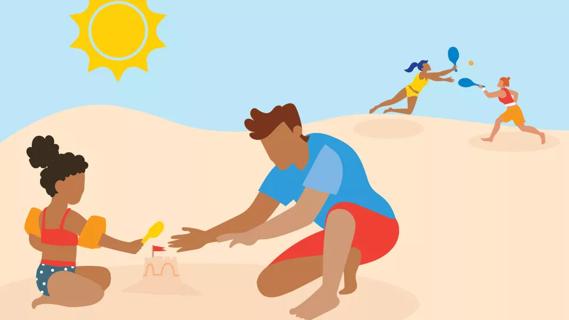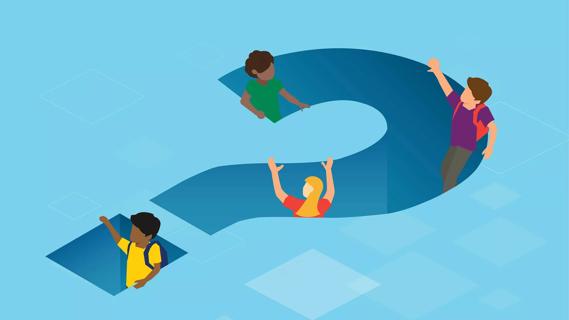Start by doing just one small thing first, and then, check it off your list

You ever just get caught up in and overwhelmed by all the details? The dishes in the sink. The overflowing laundry. The cursor blinking at you aggressively from the blank assignment page on your laptop (as if you needed another reminder about an imminent deadline).
Advertisement
Cleveland Clinic is a non-profit academic medical center. Advertising on our site helps support our mission. We do not endorse non-Cleveland Clinic products or services. Policy
No matter what you do, these things and more continue to pile up in your periphery as you direct your attention elsewhere — to your social media newsfeed, group texts, online posts and everything else going on outside your window.
When you eventually emerge from the haze, you realize time just flew by unexpectedly and you’ve got nothing done — at least nothing you set out to do.
And then, the cycle starts all over again.
If this sounds like a familiar experience — and you often find yourself stuck in this loop — you may be experiencing what many living with attention-deficit/hyperactivity disorder refer to as ADHD paralysis.
Pediatric behavioral health specialist Michael Manos, PhD, explains why ADHD paralysis isn’t actually paralysis, along with some tips to get you back on track whenever you’re feeling stuck.
ADHD paralysis isn’t a medical diagnosis. But it’s a term commonly used by people living with ADHD to describe moments in which they feel insurmountably overwhelmed and derailed by everything that’s going on around them. It’s not a true paralysis, at least not in a medical sense, but it often feels like:
Advertisement
“ADHD paralysis is not a paralysis, but it’s a reluctance or a decision to refrain from having to engage in using a kind of attention we call effortful or directed attention to complete specific tasks,” explains Dr. Manos.
Often, ADHD paralysis can be broken up into further categories that include:
“Directed attention in a person with ADHD is relatively weak, and automatic attention in a person with ADHD is relatively strong,” Dr. Manos further explains. “Having to use directed attention means you need to stop engaging in automatic attention by directing our attention to the tasks we know we must get done.”
Some examples of ADHD paralysis in action could include:
“If you go to the store for milk, eggs and butter, you might be walking through the store and see something that activates your automatic attention,” illustrates Dr. Manos. “That new thing might supersede the milk, eggs and butter directive you’ve given yourself. Sometimes, the activation of automatic attention is so potent, you might ignore that directive entirely and go home with cookies and ice cream without ever getting what you originally came for.”
When confronted with uncomfortable situations or when we feel threatened, our human brains trigger a flight, fight or freeze response. People living with ADHD often have the additional challenge of frequent distraction or difficulty hyperfocusing on very specific things. Because of this, people with ADHD more commonly have the natural, biological response to freeze or shutdown when overwhelmed with choices, tasks and decisions.
Advertisement
“In the moment of feeling overwhelmed, it looks like there’s no action that a person can take that’s going to solve the problem,” says Dr. Manos.
Lower levels of dopamine or a dopamine imbalance may also lead to an inability to be motivated — a common occurrence for people living with ADHD. When you’re unmotivated, you have a hard time making any decision, and this can heighten or prolong periods of what people refer to as ADHD paralysis.
“We tend to engage in things that make us feel strongly and we avoid things that don’t make us feel strongly or things that make us feel bored,” notes Dr. Manos. “Boredom is something people want to avoid at all costs.”
Another way to think about ADHD paralysis is to think about it as a kind of cognitive overload — when you have too many decisions at your disposal, they can sort of short circuit your executive functioning. Your executive functions determine your ability to focus, think critically and analytically, retain information, direct your attention and exert effort to accomplish tasks. For people with ADHD, difficulties with these are considered executive dysfunction.
“Being able to prioritize tasks and then engage in a task that has the highest priority is an executive function,” says Dr. Manos. “Executive functions are behaviors in your brain that you use to assist you to direct your own behavior.”
Advertisement
People living with ADHD are more prone to procrastination — the intentional decision to avoid or prolong tasks. That’s not to say people with ADHD never get things done, but it’s a common experience that even when someone with ADHD wants to accomplish tasks, the feeling of ADHD paralysis activates or exacerbates the act of procrastination.
“When you procrastinate and you push several different tasks up against the same due date, it reinforces the feeling that you’re obligated to finish each one but you no longer have the time or the capacity to be able to get them all done,” says Dr. Manos. “In that situation, when you procrastinate, that certainly feels like you can take no action to make any difference in all the things you have to do.”
Sometimes, even knowing where to start can prove difficult. These tips are geared to help you shake up ADHD paralysis when it happens and help you focus when you’re torn in different directions:
Not sure where to start? That’s OK — just do one small thing.
“The feeling of being stuck is an illusion because there’s always going to be the next action you can take,” clarifies Dr. Manos. “If there’s anything you can do, take the next action, however small it might be. And that action will open the door to the next action after that.”
Advertisement
One simple way to think about this is to break down larger projects into smaller to-do lists. That way, each individual task appears to be more manageable and enticingly easier to check off the list.
For example: Let’s say you have an article you need to turn in by a certain deadline, but you have to do research first and conduct an interview. Maybe the first thing on your to-do list is to brainstorm a list of possible sources to interview. Check that off, and you can start reaching out to one contact at a time.
“Whether it’s getting out of your seat when you have to be somewhere, or washing one fork when you have to do all of the dishes, taking one small action toward your goals can help you feel in control of what you’re doing,” says Dr. Manos.
We’re all beholden to the clock in one way or another, but if time tends to slip away from you more often than you’d like, you could split up your day based on how many hours you devote to each task. Create deadlines for yourself and stick to them. When time runs out, see where you are and how you’re feeling — and then it’s up to you if you want to keep working on that task or switch to the next. The point is that you dedicate specific time allowances to each task you’d like to complete instead of floundering on a vague notion of when you’ll get things done.
“Important to this practice is actively scheduling a ‘stop time’, when you make an agreement with yourself that you will stop working on a task,” states Dr. Manos.
All work and no play make for a dull day. So, split your tasks up by intentionally making time for breaks and other things you love to do in-between.
“A good strategy for this is the ‘when-then’ approach — when you finish the dishes, then you’re going to watch Game of Thrones,” says Dr. Manos. “No one can completely prevent boredom, but you can be intentional about the time you do have so that you’re not losing sight of what you need to complete.”
Calendars, smart watch reminders, resource and task managers — there are several tools you can use, digitally and otherwise, that can help you keep track of everything that’s on your plate. This is especially helpful if you experience brain fog and have a hard time parsing apart details between one task and the next.
“Management tools can help you figure out which tasks need to be completed, but they don’t always prompt you to take action,” Dr. Manos says. “To use these effectively, give yourself the freedom to take action.”
Another name for a management tool is an “existence system” so you don’t drop some of the tasks you’re juggling. An existence system simply takes the incomplete tasks that are ”in your head” and puts them in the physical universe where you can see them and recognize they are there rather than trying to catch a thought on the fly.
Like task managers, writing everything down can be helpful. Sometimes, people like to write down everything they’re thinking, feeling, stressed out about and need to accomplish in one go. From there, you can edit that list to things you can realistically get done right now, and then, adjust as things evolve. Or you can simply write down a list of tasks you want to complete at the start or end of your day as a way of setting yourself up for success.
“This process doesn’t have to be perfect, but you can set your mind on the things in the physical universe more readily than entertaining thoughts about them, making them easier to access and engage with,” says Dr. Manos.
Increase those dopamine levels by getting up and exercising. Do a full workout if you feel like it, or just walk around the block, jog in place or get your heart rate elevated just a little. If you’re feeling stuck, one way to increase your motivation and/or help bust up that monotony is to focus on physical activity as a way of re-wiring your focus. Small bursts of physical exercise can be a big help.
When we feel stuck, it’s hard to get ourselves out of the loop until we know which methods and tools work the best for our unique situations. These steps are helpful, but sometimes, it can be even more beneficial if you have an ADHD coach or other healthcare providers like a therapist talk to you about your diagnosis and walk you through some potential solutions for action.
“Feeling stuck is an illusion and you don’t have to get caught up in that,” reiterates Dr. Manos. “There are small things you can do to keep directing your attention to the things you care about the most. Remember, the key to loosening the grip of inaction is action itself, whatever that action may be.”
Learn more about our editorial process.
Advertisement

Background stimulation and intentional fidgeting may actually help you stay on task

A booster dose, healthy snack and some downtime may help ward off a medication rebound

Working side by side with another person can improve focus, build accountability and provide motivation to get a task done (or at least started)

The medical condition isn’t a learning disability and doesn’t always cause hyperactivity

There are times and cases when physician-supervised breaks may be beneficial

Using time management tools, adopting new approaches and allowing for a little grace can help meet deadlines and finish tasks

Boys might seem disruptive, while girls might seem inattentive, but ADHD isn’t a sex-specific condition

Both meds have similar benefits and side effects

The best parenting style balances enforcing rules and showing plenty of love

Tips include cutting back on sugar, focusing on exercise and managing stress

It can be harder to let go when you’ve invested time, energy and emotions — but it might be the healthier choice long term